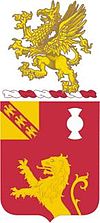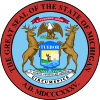119th Field Artillery Regiment
119th Field Artillery Regiment
Jump to navigation
Jump to search
This article contains wording that promotes the subject in a subjective manner without imparting real information. (May 2018) (Learn how and when to remove this template message) |
This article needs additional citations for verification. (May 2018) (Learn how and when to remove this template message) |
| 119th Field Artillery | |
|---|---|
 Coat of arms | |
| Country | United States |
| Branch | Michigan National Guard |
| Type | Field artillery |
| Nickname(s) | Red Lions |
| Motto(s) | Viam Praeparamus (We Prepare the Way) |
| Insignia | |
| Distinctive unit insignia |  |
U.S. Field Artillery Regiments | |
|---|---|
| Previous | Next |
118th Field Artillery | 120th Field Artillery |
The 119th Field Artillery Regiment is an artillery regiment of the Michigan Army National Guard and thus of the United States Army.
The 1st Battalion, 119th Field Artillery is headquartered in Lansing, Michigan.
It consists of three batteries:
- Battery A in Port Huron, Michigan
- Battery B in Alma, Michigan
- Battery C in Albion, Michigan
The 119th FA and 182nd Field Artillery (HIMARS) are the only two field artillery units in Michigan. Both are a member of the 197th Fires Brigade.
Contents
1 History
1.1 19th century
1.2 20th century
1.3 21st century
2 See also
3 References
History[edit]
What would eventually become the 1st Battalion, 119th Field Artillery Regiment began with numerous other militia units, most notably with "Rogers Rangers", the famed frontier unit of the French and Indian Wars of 1754. The Rangers, after the end of the war, left nearly 30 of their soldiers in Fort Detroit, to serve as the nucleus of the militia there. The soldiers, proud of their heritage gained while serving under Major Robert Rogers, retained much of that unit's lore, legacy, and structure, including his famous standing orders.
19th century[edit]
Eventually, that unit became a full-sized infantry militia. Prior to the Civil War, this unit was blended with cavalry and artillery units.
During the American Civil War it served as part of the famed "Iron Brigade", taking part in every major battle east of the Mississippi River, save Vicksburg, during the war.
Following the Civil War, they served in the American west and along the Mexican Border, firing in support of the famed 10th Cavalry Regiment (Buffalo
Soldiers, an all-black cavalry unit) and hunting for Pancho Villa under the command of Gen. Pershing.
During the Spanish–American War, the unit served in Cuba, firing on the San Juan Heights during the famed charge of the 10th Cavalry and another famous
unit, later-President Theodore Roosevelt's "Rough Riders".
The 119th had been described once by General John "Black Jack" Pershing as being "The legion of hell itself ... disheveled and uncut, a rowdy and miscreant lot, who fight like demonic lions and drink like gods, but in all, no better men than to have with you in combat!" The reputation for unorthodox behavior, technical expertise, and astounding courage is echoed in the annals of military history, a proud heritage for the unit, who in 1996, took the name "Red Lions" from Pershing's comments and the lion on their crest which was taken from Ponce de Leon's ranch while serving on the Mexican border.
20th century[edit]
Also the 119th saw action in both World War I and World War II in hand-to-hand combat, winning
them a distinguished honor of being called "The finest infantry unit in the artillery".
In World War I, as part of the famous 32nd Infantry Division ("Red Arrow"), the unit fought in numerous campaigns and battles in France, culminating in
their distinguished service at the Second Battle of the Marne, when they and a handful of other American units routed the German counter-offensive, and
brought an end to the war. The battalion was awarded the French Croix de Guerre for bravery and steadfast gallantry in action.
Just prior to the United States' entry into World War II, the 119th Field Artillery Regiment (155 mm Gun Motorized) was inducted into federal service on 7 April 1941 in Lansing, Michigan, and arrived at Fort Knox, Kentucky, 10 days later.
It transferred to Fort Leonard Wood in Missouri, on 2 June 1941 and was assigned to the 72nd Field Artillery Brigade, XI Corps. On 8 February 1943 it was redesignated as HHB, 119th Field Artillery Group. The regiment's former 1st and 2nd Battalions were redesignated as the 978th and 979th Field Artillery Battalions (155 mm Trac-D), respectively.
The 119th moved to Camp Young in California on 23 August 1943 and staged at Camp Myles Standish in Massachusetts from 5 February 1944 until it departed the Boston Port of Embarkation on 27 February 1944.
It arrived in England on 8 March 1944, and landed in France on 26 June 1944. The 119th crossed into Belgium on 8 September 1944, and into Holland on 13 September 1944, then
entered Germany on 14 October 1944. By August 1945 the 119th was in Ostenburg, Germany.
It returned to the United States, arriving at the Hampton Road Port of Embarkation in Virginia on 16 November 1945. It was inactivated at Camp Patrick Henry, Virginia, on 16 November 1945.
The 119th's campaign credits include Normandy, Northern France, Rhineland, Ardennes-Alsace, and Central Europe. During its tour in Europe the 119th reportedly distinguished itself for having fired more rounds in combat than any other Allied artillery unit in either the European or Pacific Theaters.
The "Korean War Order of Battle: United States, United Nations, and Communist Ground, Naval, and Air Forces, 1950-1953" by Gordon Rottman does not list the 978th or the 979th FA Battalions as having served in Korea, nor does it list the 119th FA as a regiment or group.
During the Vietnam War, one team of forward observers went to Vietnam, serving with a Long Range Recon Patrol in the Mekong River area.
In the United States, the 119th helped to respond to numerous natural disasters including the blizzards of 1968 and 1979, and also to many civil emergencies
such as riots and disturbances.
21st century[edit]
In 2001, following the September 11 Attacks by Al-Qaeda on the United States, the unit sent almost 100 troops to immediate service on the U.S.-Canadian border at the Ambassador Bridge in Detroit, and the Blue Water Bridge in Port Huron.
Those units set new records for seizures of contraband and arrests of wanted criminals and terror suspects. In six months on the Ambassador Bridge, they seized in excess of 20 million dollars (US) in illegal narcotics and contraband, stopped a child slavery ring, arrested 46 fugitives, including three wanted by Interpol, and more. Soldiers also
worked in numerous airports, facilities, and elsewhere during the crisis, ensuring the people of Michigan could sleep soundly at night.
In 2003, the unit dispatched over 150 soldiers to Guantanamo Bay, Cuba, to serve as guards and security forces for the detainment facilities recently opened there.
In 2004, 150 soldiers deployed for service at Abu Ghraib Prison in Iraq, where they set a series of distinguishing records. In the Battle of Abu Ghraib they repelled the largest attack on a U.S. military base or installation since the Vietnam War, together with the U.S. Marine Corps and other military personnel stationed at the base, on the night of 2005-04-02 and the following morning. They processed and provided security, custody, and control for over 20,000 detainees in one year, a record never before matched by any Allied facility of its type.
See also[edit]
- Michigan Army National Guard topics
- Robert Rogers' 28 "Rules of Ranging"
References[edit]
Categories:
- Field artillery regiments of the United States Army
- Michigan Army National Guard
- Field artillery regiments of the United States Army National Guard
- Military units and formations in Michigan
- Lansing, Michigan
- Albion, Michigan
- Port Huron, Michigan
(window.RLQ=window.RLQ||).push(function(){mw.config.set({"wgPageParseReport":{"limitreport":{"cputime":"0.184","walltime":"0.286","ppvisitednodes":{"value":1266,"limit":1000000},"ppgeneratednodes":{"value":0,"limit":1500000},"postexpandincludesize":{"value":56857,"limit":2097152},"templateargumentsize":{"value":8956,"limit":2097152},"expansiondepth":{"value":13,"limit":40},"expensivefunctioncount":{"value":3,"limit":500},"unstrip-depth":{"value":0,"limit":20},"unstrip-size":{"value":0,"limit":5000000},"entityaccesscount":{"value":0,"limit":400},"timingprofile":["100.00% 205.820 1 -total"," 27.61% 56.826 1 Template:Infobox_military_unit"," 24.14% 49.688 2 Template:Ambox"," 23.61% 48.601 1 Template:Infobox"," 15.70% 32.321 1 Template:Michigan"," 15.26% 31.401 1 Template:Peacock"," 14.72% 30.288 1 Template:Use_dmy_dates"," 13.91% 28.634 1 Template:US_state_navigation_box"," 13.69% 28.184 1 Template:More_citations_needed"," 12.26% 25.236 1 Template:Navbox"]},"scribunto":{"limitreport-timeusage":{"value":"0.053","limit":"10.000"},"limitreport-memusage":{"value":2036641,"limit":52428800}},"cachereport":{"origin":"mw1252","timestamp":"20181129155210","ttl":1900800,"transientcontent":false}}});});{"@context":"https://schema.org","@type":"Article","name":"119th Field Artillery Regiment","url":"https://en.wikipedia.org/wiki/119th_Field_Artillery_Regiment","sameAs":"http://www.wikidata.org/entity/Q4547710","mainEntity":"http://www.wikidata.org/entity/Q4547710","author":{"@type":"Organization","name":"Contributors to Wikimedia projects"},"publisher":{"@type":"Organization","name":"Wikimedia Foundation, Inc.","logo":{"@type":"ImageObject","url":"https://www.wikimedia.org/static/images/wmf-hor-googpub.png"}},"datePublished":"2005-11-11T07:07:36Z","dateModified":"2018-05-14T18:54:31Z"}(window.RLQ=window.RLQ||).push(function(){mw.config.set({"wgBackendResponseTime":107,"wgHostname":"mw1240"});});
